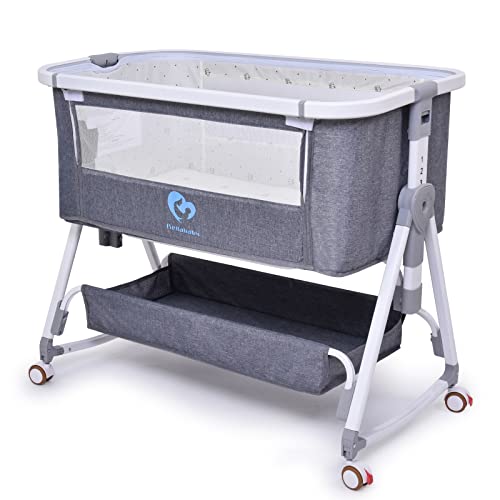10 Things Everyone Hates About Bedside Cot For Nursing

The Benefits of Using a Bedside Cot for Nursing: A Comprehensive Guide
Recently, the principle of co-sleeping, especially making use of bedside cots, has actually gotten much attention amongst new parents and caretakers. A bedside cot is a type of baby bed that is created to firmly attach to the side of an adult bed, supplying a safe sleeping environment for infants while promoting ease of access for breastfeeding mothers. This article will explore the various advantages of bedside cots for nursing, different types readily available, factors to consider for selecting one, and regularly asked questions.
The Advantages of Bedside Cots for Nursing
1. Improved Accessibility
One of the most considerable advantages of a bedside cot is the ease of access it offers. Nursing mothers can just reach over to get their baby without the need to stand or move far from bed. This convenience enables:
- Quick night feedings
- Increased convenience for the mother
- Decreased threat of disruptions to both mom and baby during nighttime care
2. Promotes Bonding
Nursing is more than simply a means of nutrition; it is likewise an opportunity for moms to bond with their infants. A bedside cot facilitates this connection by enabling moms to maintain close distance to their babies throughout sleep. This nearness can lead to:
- Enhanced psychological connection
- Increased milk production due to regular nursing
- A sense of security for the infant
3. Motivates Extended Breastfeeding
The benefit of having a bedside cot encourages longer breastfeeding durations. Moms are most likely to follow their baby's feeding hints and react promptly when they can easily access their child. The benefits of extended breastfeeding consist of:
- Improved nutritional intake for the baby
- Enhanced developmental advantages
- Strengthened immunities through breast milk
4. Supports Safe Sleep Practices
Bedside cots are created with security in mind, permitting parents to keep close supervision over their sleeping infant. By sticking to safe sleep recommendations-- such as positioning the baby on their back to sleep and making sure a firm bed mattress-- parents can develop a more secure environment. Features that contribute to safety might include:
- Breathable sides to prevent suffocation
- Strong, non-toxic materials
- Adjustable heights to match the adult bed
5. Flexible Use
A bedside cot can serve as both a crib and a co-sleeping arrangement. Lots of designs are adjustable in height or can be completely separated for use as a standalone crib when the child ages. This adaptability supplies long-term use and value.
Kinds Of Bedside Cots
Bedside cots can be found in different designs and styles. Below are some typical types:
| Type | Description |
|---|---|
| Co-Sleeping Cribs | Full-sized cribs that can be firmly connected to the side of the parents' bed. |
| Bassinet-style Cots | Smaller sized, portable cots that fit beside the bed and are light-weight for easy transport. |
| Convertible Baby Beds | Cots that change into various types of beds as the kid grows, often including toddler and youth bed options. |
| Foldable Playards | These can be used as both a sleep location and a backyard, quickly saved when not in use. |
Considerations When Choosing a Bedside Cot
When choosing a bedside cot, parents should consider a number of essential aspects:
Safety Features
- Search for mesh sides for ventilation.
- Ensure that the cot satisfies safety requirements and policies.
Alleviate of Use
- Inspect for adjustable height settings to line up with your bed.
- Think about how quickly the cot can be moved if needed.
Size and Space
- Make sure there suffices space in the bed room for the cot.
- Choose a crib that fits comfortably without taking excessive room.
Mobility
- If travel is regular, think about a lightweight model that can be easily folded and transferred.
Sturdiness and Material
- Go with top quality materials that provide toughness and are easy to tidy.
Frequently Asked Questions
1. Are bedside cots safe for sleeping?
Yes, when used correctly and following security standards, bedside cots are normally safe for infants to sleep in. Always ensure that the cot is securely connected to the adult bed and that there are no gaps.
2. Can I use a bedside cot for a newborn?
A lot of bedside cots are created for newborns and can accommodate them safely. Constantly inspect the producer's recommendations for weight limits and age suitability.
3. How can I ensure my baby's safety while using a bedside cot?
To make sure security, constantly position your baby on their back to sleep and frequently inspect that the cot is firmly attached to your bed. Preserve a clutter-free sleeping environment.
4. When should I shift my baby from a bedside cot to a crib?
Habitually, parents shift their child to a crib when they are around 4 to 6 months old or when they start to roll over often. However, the precise timing depends upon the baby's advancement.
5. Can I use a bedside cot for multiple babies?
Bedside cots are usually created for single infants. If parents have twins or multiples, it's recommended to use separate sleeping arrangements to ensure security.
Bedside cots use lots of benefits for nursing moms, consisting of availability, security, and promoting a strong bond in between mom and kid. By choosing my homepage of bedside cot and considering safety functions, parents can produce a nurturing environment for their infants. As the trend of co-sleeping continues to increase, offering a safe and comforting setup is important for the wellness of both baby and caregiver. With the right info and resources, parents can browse this new chapter in their lives better prepared than ever.

